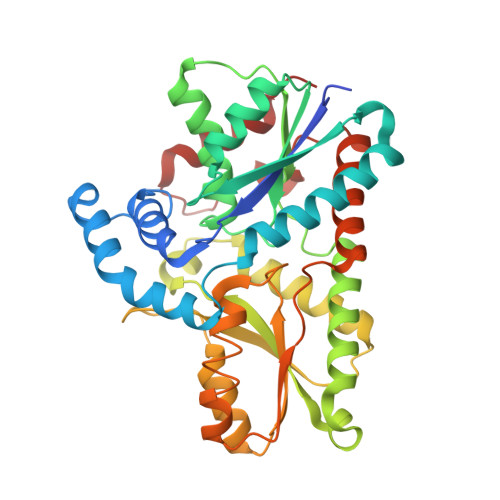Salicylic Acid induces mitochondrial injury by inhibiting ferrochelatase heme biosynthesis activity
Gupta, V., Liu, S., Ando, H., Ishii, R., Tateno, S., Kaneko, Y., Yugami, M., Sakamoto, S., Yamaguchi, Y., Nureki, O., Handa, H.(2013) Mol Pharmacol 84: 824-833
- PubMed: 24043703
- DOI: https://doi.org/10.1124/mol.113.087940
- Primary Citation of Related Structures:
3W1W - PubMed Abstract:
Salicylic acid is a classic nonsteroidal anti-inflammatory drug. Although salicylic acid also induces mitochondrial injury, the mechanism of its antimitochondrial activity is not well understood. In this study, by using a one-step affinity purification scheme with salicylic acid-immobilized beads, ferrochelatase (FECH), a homodimeric enzyme involved in heme biosynthesis in mitochondria, was identified as a new molecular target of salicylic acid. Moreover, the cocrystal structure of the FECH-salicylic acid complex was determined. Structural and biochemical studies showed that salicylic acid binds to the dimer interface of FECH in two possible orientations and inhibits its enzymatic activity. Mutational analysis confirmed that Trp301 and Leu311, hydrophobic amino acid residues located at the dimer interface, are directly involved in salicylic acid binding. On a gel filtration column, salicylic acid caused a shift in the elution profile of FECH, indicating that its conformational change is induced by salicylic acid binding. In cultured human cells, salicylic acid treatment or FECH knockdown inhibited heme synthesis, whereas salicylic acid did not exert its inhibitory effect in FECH knockdown cells. Concordantly, salicylic acid treatment or FECH knockdown inhibited heme synthesis in zebrafish embryos. Strikingly, the salicylic acid-induced effect in zebrafish was partially rescued by FECH overexpression. Taken together, these findings illustrate that FECH is responsible for salicylic acid-induced inhibition of heme synthesis, which may contribute to its antimitochondrial and anti-inflammatory function. This study establishes a novel aspect of the complex pharmacological effects of salicylic acid.
Organizational Affiliation:
Department of Biological Information, Graduate School of Bioscience and Biotechnology, Tokyo Institute of Technology, Yokohama, Japan (V.G., S.L., H.A., S.T., Y.K., M.Y., S.S., Y.Y., H.H.); and Department of Biophysics and Biochemistry, Graduate School of Science, University of Tokyo, Tokyo, Japan (R.I., O.N.).


















